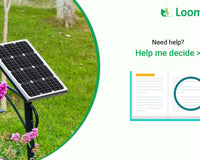Summer is coming, and many consumers are looking for the latest technology batteries for their inverters. There are two types of buyers: those who want to replace their existing battery with a new one, and those purchasing a battery for the first time. In this battery buying guide, you'll learn the fundamentals of batteries, their applications, and some important tips. First, let’s understand the basic definition of a battery. A battery is an electrochemical device that converts chemical energy into electrical energy.
Types of Batteries
There are two main types of batteries: Primary batteries and Secondary batteries.
-
Primary batteries are non-rechargeable and commonly used in watches, toys, and remote controls.
-
Secondary batteries are rechargeable and widely used in power backup systems, solar energy storage, automotive applications, and more.
In this blog, we will focus on secondary batteries and their types. The two most popular types of secondary batteries are lead-acid batteries and lithium-ion batteries.
-
Lead-acid batteries: A traditional and cost-effective power backup solution, commonly used in homes and businesses.
-
Lithium-ion batteries: A modern alternative that offers higher energy efficiency, longer lifespan, and faster charging. These batteries are becoming popular for high-capacity storage solutions.
What is a Lithium Battery?
A lithium battery is a type of rechargeable battery widely used in power backup and storage devices. It is commonly found in electric vehicles, laptops, mobile phones, toys, electric cycles, electric bikes, and energy storage systems.
Why Choose Lithium Batteries?
Lithium batteries are preferred over traditional batteries due to several advantages:
-
Fast charging
-
Lightweight
-
Longer lifespan
-
Compact design
-
Maintenance-free operation
The key component of a lithium battery is lithium cells, available in capacities such as 100Ah/48V, 100Ah/51.2V, and more.
Major Lithium Battery Capacities for Energy Storage in India
India is a growing market for energy storage systems, second only to Australia. While batteries were traditionally used in areas with frequent power cuts, they are now essential for grid stability, reducing peak demand tariffs, microgrids, and more.
The major buyers of Battery Energy Storage Systems (BESS) include DISCOMs (electricity distribution companies), electric vehicle manufacturers, storage solution providers, and telecom companies.
Lithium battery capacities start from 5kWh and can go up to MWh levels. These batteries are typically customized to meet specific requirements rather than being standardized products.
How to Choose a Lithium Battery for Power Backup Solutions
At Loom Solar, a leading lithium-ion battery manufacturer based in Faridabad, Haryana, we provide lithium batteries for residential, commercial, industrial, and government sectors. With over seven years of experience in the solar energy sector, we have served more than 100,000 customers across India.
When selecting a power backup solution, consider the following factors:
-
Load/Power Consumption – Identify your peak load and regular load requirements. Typically, regular load consumption should be the primary consideration.
-
Backup Time – Determine how many hours of backup you need in case of a power outage.
-
Efficiency – Inverter and battery efficiency is approximately 80%.
-
Load Distribution – Properly distribute the load when installing an energy storage system.
-
Phase Balancing – If you have a three-phase connection, ensure proper phase balancing.
Conclusion
In this lithium battery buying guide, we have covered the fundamentals of batteries, their types, and how to choose the right one for power backup solutions. If you’re planning to invest in a reliable energy storage solution, lithium batteries offer a superior alternative to traditional lead-acid options.
For more details on customized lithium battery solutions, feel free to contact Loom Solar!












